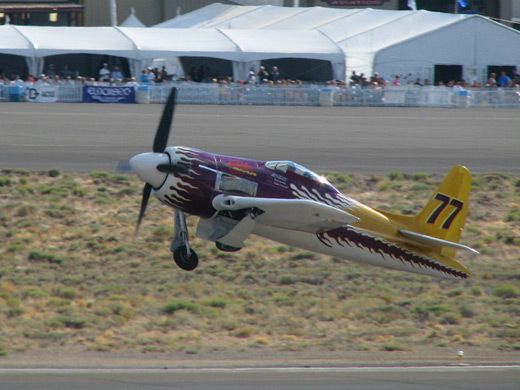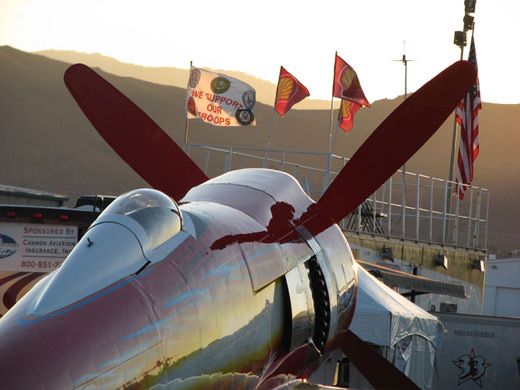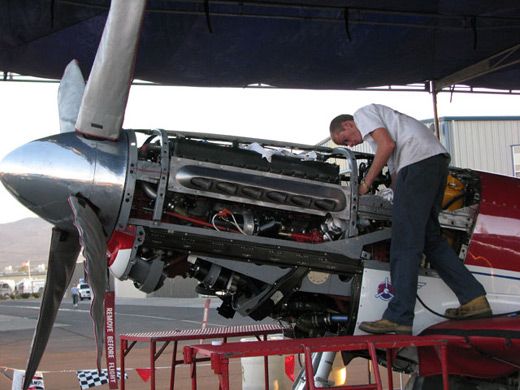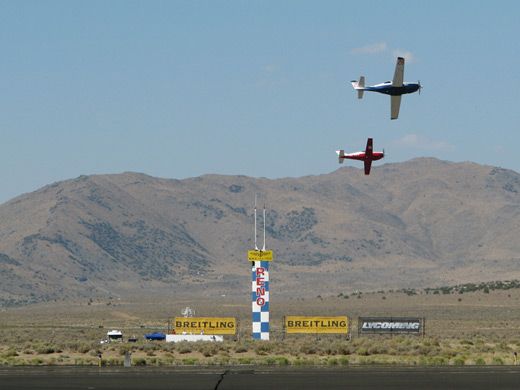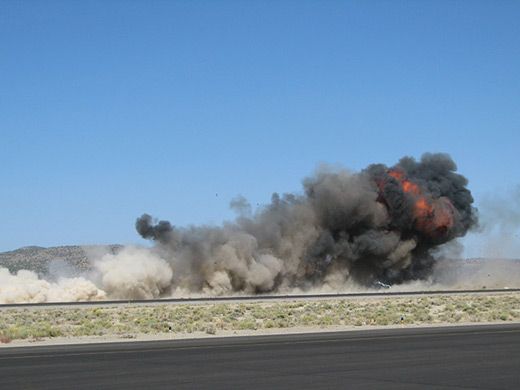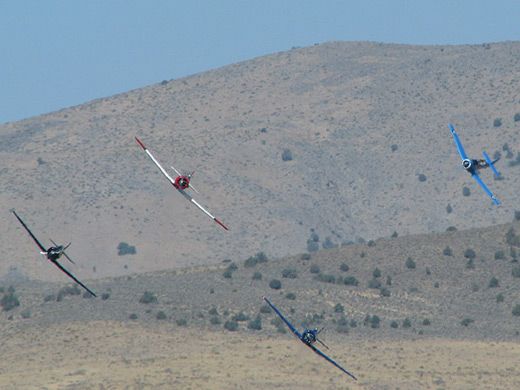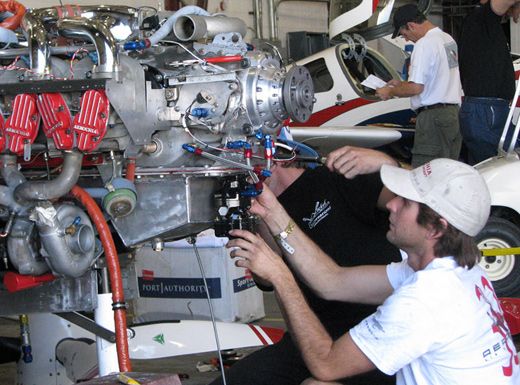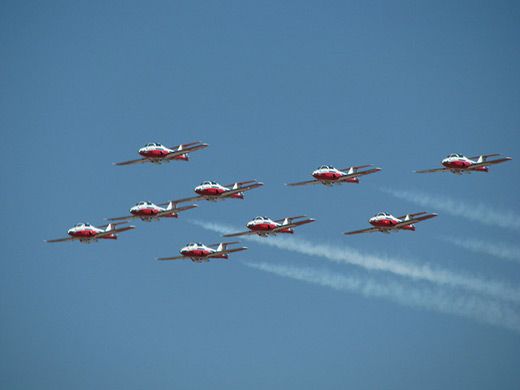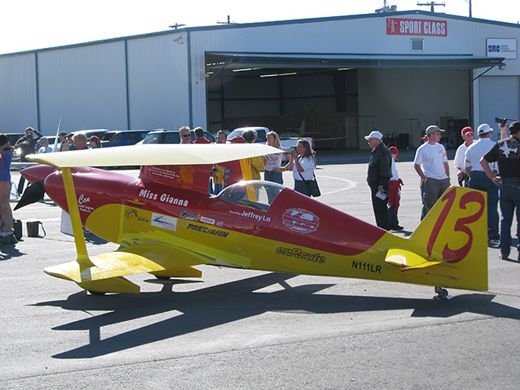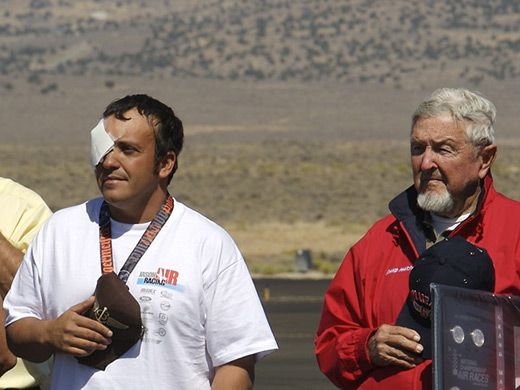Notes from the Reno Races
Dispatches from the 2007 National Championship Air Races.
/https://tf-cmsv2-smithsonianmag-media.s3.amazonaws.com/filer/Rare_Bear-388-sept07.jpg)
Air & Space contributor Larry Lowe reports from the Reno National Championship Air Races and Airshow, which runs from September 12-16.
Sunday afternoon: A day at the races
After the intensity of the week, two days of air racing is just what the doctor ordered—and just what the fans got on Saturday and Sunday. Following the morning events and the opening ceremonies, the Reno, and the natural amphitheater here highlights the grace of their performance. The team’s nine aircraft paid tribute to the fallen racers, adding one figure as a memorial to one of their own team members lost earlier this year. The small CT-114 Tutor trainers flown by the Canadians may not have the sleekness of the Thunderbirds’ F-16s or the Blue Angels’ F-18s, but the Snowbirds more than make up for it with the elegance of their performance.
Details of this week’s accidents have begun to emerge from the fog of speculation. The biplane that crashed on Tuesday night had had a number of modifications and had never flown in the configuration it flew on Tuesday. Another biplane racer told me he believed that overeagerness to participate in the races was a factor in the accident. Taking off uphill on Runway 8, the engine, which had not appeared to be performing well on the ground, failed shortly after liftoff. There’s a small bluff off the end of the runway that precluded a straight ahead roll out. While attempting to turn to find a place to land, the airplane stalled at low altitude.
An unlimited pilot who witnessed Brad Morehouse’s accident on Thursday said that in the grip of the wake turbulence, the L-39 Albatros rolled twice, but that Morehouse regained control of the airplane prior to impact. Right side up, aileron against the roll, he was within 10 feet or so of pulling the jet out of the descent when he hit the ground.
The two formula pilots were heading uphill into the early morning sun. Overtaking pilot Jason Somes had passed wide as the pair Gary Hubler’s airplane, still on the inside of the turn, accelerated—as formula ones are prone to do when the airspeed gets high enough where the high-pitch racing prop can begin to let the engine develop higher RPM. As both planes converged on the pylon, neither could see the other, and by sheer chance the two intersected the same point at the same time. “You could try to do that with a couple of airplanes 100 times and not get it right,” a pilot who saw the event told me. The two racers converged, and Hubler’s airplane shredded the aft end of Somes’.
Jason Somes suffered substantial injuries, and at first it seemed as if he might lose the use of one eye. Successful surgery on his face and eye saved his sight. Somes participated in the Sunday opening ceremonies, standing next to Reno Air Race Association CEO Mike Houghton, media director Valerie Enos, and Formula One air racing legend Ray Cote.
“We are fortunate to have the very best, most skilled pilots in the world compete and perform in northern Nevada each year,” Houghton said. “The entire sport mourns the loss of three fierce competitors, and we all mourn the loss of three dear friends.”
By Sunday it was clear that fears expressed during the stand-down that the accidents might mean the end of air racing at Reno were likely overblown. Although each accident will be reviewed to see if procedures can be improved, racing is almost certainly going to continue at Reno.
Chris Ferguson won the 2007 Biplane Gold championship Sunday morning in his Pitts LR-1, “Miss Gianna,” at a speed of 233.470 miles per hour. The sophisticated “Phantom,” which has been having engine problems all week, pulled out after one lap. Following on Ferguson’s heels were Norman Way at 208.975 in “Magic” and Dennis Vest in “Drag Racer” at 200.924 mph. Rookie Pat McGarry was all smiles in fourth place in a cleaned-up S1S Pitts Special called “Rollin’.”
David Hoover took first place in the 2007 Formula One Gold Race at 245.669 in his Arnold AR-6 “Endeavor,” followed by George Andre at 238.399 in the Cassutt “Zipper” and Scotty Crandlemire in the Cassutt III “Outrageous” at 237.997.
In Sport Class, the highly anticipated contest between Andy Chiavetta’s Super Legacy and the NXT racers flown by Jon Sharp and Kevin Eldridge didn’t materialize. The NXT Super Sport raceplanes are wicked fast, the pair posting qualifying times of 378 and 380 miles per hour, speedy enough to beat 16 of the airplanes in the Unlimited field. Chiavetta’s airplane had a reputed 900-horsepower engine built by Greg Stephenson. But a series of gearbox and prop problems kept the four-time Sport Class champion out of today’s race. “I just don’t think we are running well enough to put Rod [Von Grote, the pilot] in the airplane,” said a clearly disappointed Chiavetta.
In Unlimited, all eyes were on longtime favorite “Rare Bear,” sporting a new paint scheme and under new ownership. The former champion took off for Saturday’s Gold race heat but couldn’t develop full power and placed third at 446.626 behind Matt Jackson in Dreadought at 452.903 mph and Mike Brown in “September Fury” at 470.055. Rare Bear’s crew obviously found the problem, however. The Bear was heard emitting a healthy growl as pilot John Penney opened it up for a full throttle test early Sunday, and the stage was set for a classic Reno shootout between “Rare Bear” and the larger, more powerful Sea Furies.
In the end, “Rare Bear” took the race in commanding style, with a speed of 478.394 mph. Penney claimed an early lead and never relinquished it. Then, after finishing his race, he called an emergency and had to make a deadstick landing on runway 22.
Reno is nothing if not dramatic.
Saturday afternoon: Back to racing
After all events were suspended on Friday an unnatural calm settled on Reno-Stead airport while fans and racers absorbed the impact of three deaths in four days. On Saturday morning, things began to pick up again. As I write this, Mike Brown’s F7F Tigercat is neck and neck, improbably, with a P-51. Two seconds behind them, a Bearcat and another Mustang are locked in a contest for their position. A string of Mustangs follow up in tight trail. Best of all is the whistling whine of the jet class.
We’re racing again at Reno.
Not that everything is completely back to normal. The first accident on Tuesday left experienced racers analyzing the event as professional pilots always do, asking themselves what chain of events left Steve Dari with no more options. His crash had been an operational accident, not a racing accident, and could just as likely have happened elsewhere. That helped the pilots tuck the incident in the back of their minds and move on.
Thursday’s accident was a far more dramatic blow to the collective psyche. Second year jet racer Brad Morehouse got tangled up in the wake turbulence of the jet in front of him, flipped through a roll and slammed into the ground, shattering the airplane and instantly extinguishing Morehouse’s life. The debris ricocheted into the air and came to rest in a long flaming swath across the show center, the smoke obscuring the home pylon.
The photo in the Reno Gazette-Journal the next day was dramatic, but not as powerful as it might have been. The press corps self-censored some of the worst pictures, providing images to officials for use in analyzing the accident, but foregoing significant fees by not releasing them for publication.
Late Friday, I polled the pilots in Sport Class, who delivered a calm, deliberate and consistent message. It had probably been wise to pause, but the consensus was that they know how to police themselves, and were good to go. You could look them in the eye and know it wasn’t the macho talking.
Friday, noon: Three accidents in four days
A somber mood. Racing has been suspended for the remainder of today after a mid-air collision in a Formula One race this morning took the life of Gary Hubler of Caldwell, Idaho. Following on the heels of another accident Thursday that killed Brad Morehouse, who was flying an L-39 Albatros jet, race director Mike Houghton decided to call a halt. The unprecedented move will let the presidents of each racing class review the situation with the pilots and make certain "their heads are in the right place" to continue racing, said Houghton.
Hubler’s fatality is the third in four days, and has taken everyone here aback. I’ll have a fuller report once we get more details.
Wednesday evening: The calm before the storm
For the Reno faithful, Wednesday evening is a special time. The qualifying rounds are done, the casual fans have departed, and the sun is slowly working its way toward the western ridge line. A satisfying calm settles in as old friendships are renewed and notes compared. Tomorrow the race begins in earnest as the fastest airplanes in each class take to the course.
For those who aren’t familiar with this gem of an airshow, the Reno National Championship Air Races are a unique experience. They’re part living history, part technological proving ground, and mostly a hell of a lot of fun for those who make a point to be here every year.
Back in the 1930s, air racing was as big a part of the national sports scene as NASCAR is today. But after World War II, a string of fatal crashes caused the sport to nearly disappear. It was reinvented here in the 1960s. The high desert outside Reno seemed like the perfect place; there was plenty of room for propeller-driven World War II fighters to make their turns without asking more of the airplane than it could reliably give. And the ethos of Reno was right. It’s a place where prostitution was legal, gambling an industry, and divorce a matter of two weeks and some paperwork; likewise, pilots came to Reno partly for the waivers that exempt them from normal FAA rules. The low flying and excessive speed pilots enjoy in Reno would get them busted for reckless flying in the real world.
Racing at Reno is old school. Airplanes fly in a cluster around a course defined by phone poles topped by 55-gallon drums, every pilot searching for that elusive edge over his or her opponents. Racing at Reno is less difficult than ordinary airshow flying but arguably more dangerous. That was brought home in a briefing conducted by media manager Valerie Enos, who concludes her pre-race school for reporters with a heartfelt plea for sensitivity in the event a photographer or writer witnesses the end of someone’s racing career. "Remember the pilot flying," she says. "Remember they have a family."
It’s only Wednesday and Reno ‘07 has already underscored her point. Yesterday a biplane pilot from California, Steve Dari, was killed during practice. Word on the ramp was that the condition of the engine was a factor, but that’s the kind of speculation Enos would just as soon not see offered as reporting. Earlier in the week, a Mustang aborted a high-speed takeoff and ran off the end of the runway. The brakes were so hot that the brush caught fire and the flames destroyed the airframe. Today one T-6 taxied into another, and the latter lost its tail surfaces. The simple fact is that Reno can be riskier than most airshows.
This evening, after the airspace waiver expires, a pair of F-16s intended for static display on the grounds show up, booming afterburners. The call of the Unlimited course (for airplanes over 4,500 pounds) proves too strong, and the lead pilot roars down to take a lap around the course, while his wingman flies top cover. Few pilots with a high-performance airplane will turn down the chance to run the pylons at Reno—even if it’s an unofficial lap performed solely for bragging rights.
Other pilots sit under the wings of their racers or around them in the hangars, making small talk. For some, the day before racing includes a frantic effort to rebuild a broken airplane. Andy Chiavetta has taken the engine out of Sport Race #33 and spirited it to a secret location in the mountains near Tahoe, where a mad scientist of the propulsive arts is reputed to live. Sometime past midnight, they will be installing the engine on the airframe in time for the 9:40 a.m. first race Thursday. The Unlimited Gold-winning P-51 Strega is also having engine problems, as is Voodoo, two stalls down.
The mechanics are focused; there is no time now to waste. In the gathering dusk the Griffon-powered P-51 Precious Metal returns from a photo mission, makes a pass down the runway, and lands.
Tomorrow we begin.
